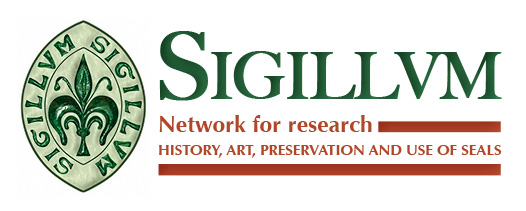History
History of SIGILLVM
(Paul D. A. Harvey, University of Durham)
In 1958 the International Council on Archives (ICA) set up a Committee on Sigillography with the aim of promoting the study – and, above all, the safeguarding – of the immense historical and artistic heritage of the seals to be found, in particular, in European archive repositories. Among those most concerned in founding the Committee were the historian Robert-Henri Bautier and the archivist Yves Metman.
In the years that followed, the Committee, in principle a committee of archivists, did much to draw the attention of national and other archive administrations to the problems of looking after seals: their vulnerability, the need for specific catalogues, their low profile in work on documents. Successive questionnaires circulated to repositories in 1960, 1964 and 1983 succeeded in bringing to light some of the difficulties then met with under all these heads and led to many small steps being taken to resolve them.
Other work of the Committee included publications. It produced – corporately – the Vocabulaire international de la sigillographie that was published at Rome in 1990 by the Ministero per i Beni Culturali e Ambientali (Pubblicazioni degli Archivi di Stato, Sussidi 3) which defines and translates into twelve European languages over 300 of the terms used in describing seals; it takes French as its starting-point, but there are indexes in each of the twelve languages. Another publication was Il messaggio dei sigilli, published in the Vatican City in 2002 by the Scuola vaticana di Paleografia, Diplomatica e Archivistica; in this, a general account of European sigillography (in Italian) by Faustino Menéndez Pidal de Navascués, a member of the Committee, was followed by a select bibliography arranged under four heads for each country (bibliographies; manuals; catalogues; journals).
Further publications record the proceedings of another initiative of the Committee: round tables that brought together seal conservators from many countries to discuss the techniques of storing, repairing and reproducing seals. They were held in Madrid in 1995, in Paris in 2003 and Oxford in 2007. It is to be hoped that Sigillum will see its way to continuing this programme.
In 2004 the ICA made an important change in its structure. While committees might be formed for particular short-term purposes, permanent committees such as the Committee on Sigillography were abolished, and the only subdivisions of the ICA were to be its branches (each covering a geographical region) and its sections (each covering a particular subject). The Committee was re-formed as the Provisional Section on Sigillography, but for a section to become permanently established it had to attract within eight years at least fifty subscribing members, from different parts of the world, all of them working archivists. The Committee had always looked beyond Europe to the wider aspects of sigillography; from 1995 it had much valued having as a member Mr Hu Zhong-Liang, of the First Historical Archives of China at Beijing, and with his help an exhibition was prepared that travelled in China after the ICA Congress in Beijing in 1996. However, the expansion required for the Provisional Section to become permanent was far beyond its resources, financial administrative and human, and it is thus automatically abolished in 2012.
It was in this situation that the idea of Sigillum was conceived. The Committee on Sigillography had long been aware of the distortion imposed – unavoidably – by being part of the ICA. Interest in seals, the study of seals, is by no means restricted to the archivists who alone could be members of the Committee, though it is fair to say that this had always been liberally interpreted, so that it had included several former archivists and curators and had always had close contact with sigillographers with no archival background. However, the wide membership that Sigillum hopes to achieve is entirely in keeping with the aims and aspirations of the Provisional Section, while Sigillum’s Archivists’ Group is expected to take over and carry forward its current archive-oriented projects.
In many ways Sigillum is thus regularising and building on an existing situation – and in its aim of rapidly expanding beyond the bounds of medieval Europe it is taking forward the interests of the Committee that was for some fifty years the only international body dedicated to seals. By way of a postscript it is worth recording that the Committee on Sigillography to the end conducted its business in French, the last committee of the ICA to do so in the face of creeping anglicisation.
